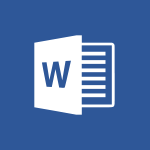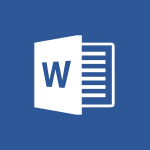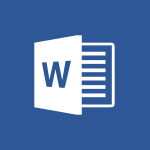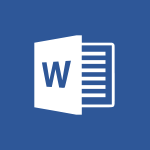Word - Use landscape and portrait orientation Video
In this video, you will learn about using landscape and portrait orientation in Microsoft 365. The video covers how to adjust the orientation of your documents and presentations to either landscape or portrait mode.
This will help you create professional-looking documents and presentations that are tailored to your specific needs.
- 3:28
- 2620 views
-
OneDrive - What is OneDrive ?
- 01:14
- Viewed 1574 times
-
Outlook - Create and modify a group
- 2:19
- Viewed 4351 times
-
OneDrive - Edit, Delete a Share
- 02:16
- Viewed 1036 times
-
Power BI - Introduction to Power Bi
- 1:29
- Viewed 6380 times
-
Teams Premium - Activate the features of Teams Premium
- 3:48
- Viewed 13715 times
-
Teams Premium - Optimize Teams Premium settings in Administration
- 1:27
- Viewed 2607 times
-
Viva Engage - The role of an administrator
- 2:22
- Viewed 4818 times
-
Collapsible headings
- 3:03
- Viewed 6688 times
-
Navigation Pane Part 1 : Rearranging a document
- 2:32
- Viewed 3852 times
-
Copy & Paste
- 3:09
- Viewed 3615 times
-
Introduction to Word
- 0:59
- Viewed 3506 times
-
More things you can do with pictures
- 4:53
- Viewed 3206 times
-
Change footnote font, size, and formatting
- 2:48
- Viewed 3189 times
-
Insert icons
- 0:43
- Viewed 3145 times
-
Locate your documents
- 0:20
- Viewed 3127 times
-
Microsoft Search
- 0:34
- Viewed 3096 times
-
Introduction to Tables of Contents
- 2:57
- Viewed 3086 times
-
More options and custom labels
- 3:59
- Viewed 3064 times
-
Insights into what you're working on
- 0:36
- Viewed 2979 times
-
Use dictate to type in Word
- 0:27
- Viewed 2973 times
-
Faster shape formatting and new and modern chart types
- 1:04
- Viewed 2944 times
-
Mail merge
- 3:51
- Viewed 2938 times
-
Take tables of contents (TOCs) to the next level
- 3:51
- Viewed 2933 times
-
3D Models
- 0:42
- Viewed 2929 times
-
Add a logo or other picture
- 3:17
- Viewed 2912 times
-
Format a document
- 2:58
- Viewed 2896 times
-
Translate Content in Word
- 2:04
- Viewed 2896 times
-
Format and add a graphic
- 3:20
- Viewed 2876 times
-
Save, export and share
- 2:08
- Viewed 2832 times
-
Insert items in a document
- 2:59
- Viewed 2827 times
-
Translate your Word documents into any language
- 0:33
- Viewed 2820 times
-
Let Word read your documents out loud
- 0:36
- Viewed 2814 times
-
Ink Equation
- 0:43
- Viewed 2782 times
-
Edit document with natural gestures
- 0:34
- Viewed 2779 times
-
A first look at Word 2016
- 3:16
- Viewed 2738 times
-
Print envelopes with mail merge
- 3:58
- Viewed 2736 times
-
Track changes online
- 3:14
- Viewed 2736 times
-
Design considerations for orientation
- 2:00
- Viewed 2721 times
-
Add headers, footers, margins, and rulers to a page
- 2:45
- Viewed 2705 times
-
Accessibility in Word
- 2:29
- Viewed 2697 times
-
Insert and customize a footnote
- 3:04
- Viewed 2689 times
-
How things are organized
- 2:00
- Viewed 2676 times
-
Check Accessibility in Word
- 1:42
- Viewed 2658 times
-
Navigation Pane Part 2 : Search Options
- 1:35
- Viewed 2630 times
-
Custom margin - Headers and footers
- 1:29
- Viewed 2608 times
-
A closer look at the ribbon
- 3:54
- Viewed 2595 times
-
Track changes in email with multiple people
- 4:36
- Viewed 2594 times
-
Modify a TOC with field codes
- 2:59
- Viewed 2591 times
-
Focus on priorities with the Immersive Reader
- 1:13
- Viewed 2591 times
-
Advanced mail merge (Field code)
- 2:59
- Viewed 2586 times
-
Add multiple TOCs to a document
- 4:59
- Viewed 2555 times
-
Create and print labels
- 3:05
- Viewed 2510 times
-
Chat with co-authors while editing
- 0:29
- Viewed 2504 times
-
Incorporate revisions with track changes
- 3:10
- Viewed 2484 times
-
Pin your important files
- 0:34
- Viewed 2468 times
-
Do things quickly with Tell Me
- 1:04
- Viewed 2425 times
-
Get going fast
- 1:44
- Viewed 2412 times
-
Print letters with mail merge
- 4:02
- Viewed 2405 times
-
Use mail merge to create multiple labels
- 3:21
- Viewed 2393 times
-
Add custom entries to a TOC
- 3:00
- Viewed 2386 times
-
Start working together in a document
- 2:03
- Viewed 2382 times
-
Add formatting to a TOC
- 3:48
- Viewed 2378 times
-
Advanced tables of contents
- 3:15
- Viewed 2347 times
-
Track changes
- 2:34
- Viewed 2346 times
-
Work together in real time
- 1:40
- Viewed 2330 times
-
Customize track changes
- 2:18
- Viewed 2325 times
-
Changing existing styles
- 1:08
- Viewed 2293 times
-
Custom margin - Default margin
- 1:06
- Viewed 2265 times
-
Styles
- 1:49
- Viewed 2261 times
-
Working with watermarks
- 2:48
- Viewed 2146 times
-
Improved version history
- 0:56
- Viewed 2117 times
-
Creating Styles
- 1:03
- Viewed 2111 times
-
Custom margin
- 1:59
- Viewed 2093 times
-
Introducing to Word
- 01:00
- Viewed 166 times
-
Introduction to PowerBI
- 00:60
- Viewed 168 times
-
Introduction to Microsoft Outlook
- 01:09
- Viewed 159 times
-
Introduction to Microsoft Insights
- 02:04
- Viewed 157 times
-
Introduction to Microsoft Viva
- 01:22
- Viewed 163 times
-
Introduction to Planner
- 00:56
- Viewed 171 times
-
Introduction to Microsoft Visio
- 02:07
- Viewed 159 times
-
Introduction to Microsoft Forms
- 00:52
- Viewed 165 times
-
Introducing to Microsoft Designer
- 00:28
- Viewed 224 times
-
Introduction to Sway
- 01:53
- Viewed 143 times
-
Introducing to Word
- 01:00
- Viewed 166 times
-
Introducing to SharePoint Premium
- 00:47
- Viewed 147 times
-
Create a call group
- 01:15
- Viewed 200 times
-
Use call delegation
- 01:07
- Viewed 128 times
-
Assign a delegate for your calls
- 01:08
- Viewed 200 times
-
Ring multiple devices simultaneously
- 01:36
- Viewed 136 times
-
Use the "Do Not Disturb" function for calls
- 01:28
- Viewed 126 times
-
Manage advanced call notifications
- 01:29
- Viewed 142 times
-
Configure audio settings for better sound quality
- 02:08
- Viewed 173 times
-
Block unwanted calls
- 01:24
- Viewed 140 times
-
Disable all call forwarding
- 01:09
- Viewed 142 times
-
Manage a call group in Teams
- 02:01
- Viewed 133 times
-
Update voicemail forwarding settings
- 01:21
- Viewed 130 times
-
Configure call forwarding to internal numbers
- 01:02
- Viewed 123 times
-
Set call forwarding to external numbers
- 01:03
- Viewed 148 times
-
Manage voicemail messages
- 01:55
- Viewed 188 times
-
Access voicemail via mobile and PC
- 02:03
- Viewed 205 times
-
Customize your voicemail greeting
- 02:17
- Viewed 125 times
-
Transfer calls with or without an announcement
- 01:38
- Viewed 121 times
-
Manage simultaneous calls
- 01:52
- Viewed 132 times
-
Support third-party apps during calls
- 01:53
- Viewed 161 times
-
Add participants quickly and securely
- 01:37
- Viewed 132 times
-
Configure call privacy and security settings
- 02:51
- Viewed 130 times
-
Manage calls on hold
- 01:20
- Viewed 139 times
-
Live transcription and generate summaries via AI
- 03:43
- Viewed 127 times
-
Use the interface to make and receive calls
- 01:21
- Viewed 131 times
-
Action Function
- 04:18
- Viewed 139 times
-
Search Function
- 03:42
- Viewed 189 times
-
Date and Time Function
- 02:53
- Viewed 170 times
-
Logical Function
- 03:14
- Viewed 256 times
-
Text Function
- 03:25
- Viewed 200 times
-
Basic Function
- 02:35
- Viewed 159 times
-
Categories of Functions in Power FX
- 01:51
- Viewed 189 times
-
Introduction to Power Fx
- 01:09
- Viewed 161 times
-
The New Calendar
- 03:14
- Viewed 282 times
-
Sections
- 02:34
- Viewed 172 times
-
Customizing Views
- 03:25
- Viewed 166 times
-
Introduction to the New Features of Microsoft Teams
- 00:47
- Viewed 273 times
-
Guide to Using the Microsoft Authenticator App
- 01:47
- Viewed 186 times
-
Turn on Multi-Factor Authentication in the Admin Section
- 02:07
- Viewed 146 times
-
Concept of Multi-Factor Authentication
- 01:51
- Viewed 173 times
-
Retrieve Data from a Web Page and Include it in Excel
- 04:35
- Viewed 393 times
-
Create a Desktop Flow with Power Automate from a Template
- 03:12
- Viewed 334 times
-
Understand the Specifics and Requirements of Desktop Flows
- 02:44
- Viewed 206 times
-
Dropbox: Create a SAS Exchange Between SharePoint and Another Storage Service
- 03:34
- Viewed 350 times
-
Excel: List Files from a Channel in an Excel Workbook with Power Automate
- 04:51
- Viewed 222 times
-
Excel: Link Excel Scripts and Power Automate Flows
- 03:22
- Viewed 228 times
-
SharePoint: Link Microsoft Forms and Lists in a Power Automate Flow
- 04:43
- Viewed 405 times
-
SharePoint: Automate File Movement to an Archive Library
- 05:20
- Viewed 199 times
-
Share Power Automate Flows
- 02:20
- Viewed 194 times
-
Manipulate Dynamic Content with Power FX
- 03:59
- Viewed 198 times
-
Leverage Variables with Power FX in Power Automate
- 03:28
- Viewed 185 times
-
Understand the Concept of Variables and Loops in Power Automate
- 03:55
- Viewed 197 times
-
Add Conditional “Switch” Actions in Power Automate
- 03:58
- Viewed 232 times
-
Add Conditional “IF” Actions in Power Automate
- 03:06
- Viewed 168 times
-
Create an Approval Flow with Power Automate
- 03:10
- Viewed 361 times
-
Create a Scheduled Flow with Power Automate
- 01:29
- Viewed 584 times
-
Create an Instant Flow with Power Automate
- 02:18
- Viewed 338 times
-
Create an Automated Flow with Power Automate
- 03:28
- Viewed 328 times
-
Create a Simple Flow with AI Copilot
- 04:31
- Viewed 306 times
-
Create a Flow Based on a Template with Power Automate
- 03:20
- Viewed 274 times
-
Discover the “Build Space”
- 02:26
- Viewed 193 times
-
The Power Automate Mobile App
- 01:39
- Viewed 201 times
-
Familiarize Yourself with the Different Types of Flows
- 01:37
- Viewed 194 times
-
Understand the Steps to Create a Power Automate Flow
- 01:51
- Viewed 282 times
-
Discover the Power Automate Home Interface
- 02:51
- Viewed 188 times
-
Access Power Automate for the Web
- 01:25
- Viewed 298 times
-
Understand the Benefits of Power Automate
- 01:30
- Viewed 246 times
Objectifs :
This video aims to teach users how to effectively use different page orientations in Microsoft Word, specifically how to switch between portrait and landscape orientations for various content types, and how to manage mixed orientations within a single document.
Chapitres :
-
Understanding Page Orientation
In Microsoft Word, choosing the right page orientation is crucial for presenting your content effectively. Portrait orientation is typically used for text-heavy documents, while landscape orientation is better suited for wide content such as tables or charts. -
Changing Page Orientation
To change the orientation of your document, follow these steps: 1. Go to the 'Layout' tab. 2. Click on 'Orientation'. 3. Select 'Landscape'. This will rotate your document 90 degrees, providing more horizontal space for your content. -
Creating Mixed Orientation Documents
You can create a document that contains both portrait and landscape pages. To do this: 1. Right-click the 'Table Selection' icon and choose 'Table Properties'. 2. Under the 'Table' tab, ensure 'Text wrapping' is set to 'None' and click 'OK'. 3. Go to the 'Layout' tab and click the 'Dialog Box Launcher' in the 'Page Setup' group. 4. On the 'Margins' tab, select 'Landscape' under 'Orientation'. 5. Click the arrow next to 'Apply to' and choose 'Selected text'. 6. Click 'OK'. This will change only the selected text to landscape orientation. -
Using Section Breaks
When you apply landscape orientation to selected text, Word automatically adds section breaks before and after the table. This allows the table to exist in its own section on a separate page, while the rest of the document remains in portrait orientation. To manually add a section break: 1. Go to the 'Layout' tab. 2. Click on 'Breaks'. 3. Under 'Section Breaks', select 'Next Page'. This feature also enables you to adjust margins specifically for landscape pages without affecting the entire document. -
Viewing Multiple Page Orientations
To view your document with both portrait and landscape pages: 1. Go to the 'View' tab. 2. Click on 'Multiple Pages'. This allows you to see how the landscape page fits within the portrait pages. -
Conclusion
By understanding how to manipulate page orientations and section breaks in Microsoft Word, you can create more visually appealing and organized documents. This flexibility allows for better presentation of diverse content types, enhancing the overall readability and effectiveness of your documents.
FAQ :
How do I change the orientation of a document in Word?
To change the orientation of a document in Word, go to the Layout tab, click on Orientation, and select either Portrait or Landscape.
Can I have both portrait and landscape pages in the same Word document?
Yes, you can have both portrait and landscape pages in the same Word document by using section breaks. Select the text you want to change, go to the Layout tab, and choose Breaks to insert a section break.
What is the purpose of section breaks in Word?
Section breaks allow you to change the layout or formatting of specific parts of a document without affecting the entire document. This includes changing margins, orientation, and other settings.
How do I adjust column widths in a table?
To adjust column widths in a table, click on the table to select it, then drag the borders of the columns to the desired width or use the Table Properties settings.
What does the 'Show/Hide Paragraph Marks' feature do?
The 'Show/Hide Paragraph Marks' feature displays formatting marks in your document, such as spaces, paragraph breaks, and section breaks, which can help you understand the layout of your document.
Quelques cas d'usages :
Creating a Report with Mixed Orientations
In a business report that includes both text and data tables, you can use portrait orientation for the text sections and landscape orientation for the tables. This improves readability and presentation.
Designing a Presentation Handout
When creating handouts for a presentation, you can use landscape orientation for slides with images or charts, while keeping text pages in portrait orientation. This allows for a more visually appealing layout.
Formatting a Research Paper
In a research paper, you may need to include wide tables or figures. By using section breaks, you can format those specific pages in landscape orientation while keeping the rest of the paper in portrait format.
Creating a Multi-Page Brochure
When designing a brochure, you can use different orientations for different sections. For example, use landscape for a wide image and portrait for text descriptions, enhancing the overall design.
Adjusting Layout for a Newsletter
In a newsletter, you can mix orientations to highlight different content types. Use landscape for large images or tables and portrait for articles, making the newsletter more engaging.
Glossaire :
Orientation
The direction in which a document is displayed or printed, typically either portrait (vertical) or landscape (horizontal).
Portrait Orientation
A vertical layout where the height of the document is greater than its width, commonly used for text documents.
Landscape Orientation
A horizontal layout where the width of the document is greater than its height, often used for tables and images.
Table Properties
Settings that define the layout and formatting of a table within a document, including text wrapping and alignment.
Text Wrapping
The way text flows around a table or image in a document. 'None' means text will not wrap around the table.
Margins
The blank spaces around the edges of a document that separate the text from the edges of the page.
Section Break
A marker in a document that divides it into sections, allowing for different formatting options in each section.
Dialog Box Launcher
An icon that opens a dialog box for more detailed settings and options related to a specific feature in a software application.




